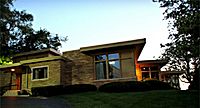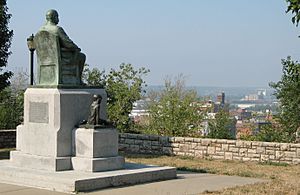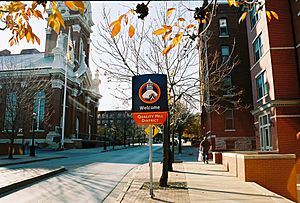Quality Hill, Kansas City facts for kids
Quick facts for kids |
|
|
Quality Hill
|
|
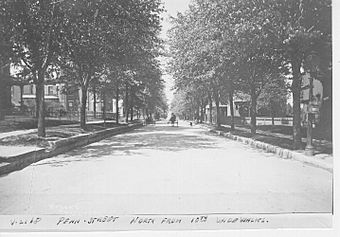
View down Pennsylvania Avenue from the 1910s
|
|
| Location | Kansas City, MO |
|---|---|
| Architect | Louis S. Curtiss |
| Architectural style | Queen Anne |
| NRHP reference No. | 78001657 |
| Added to NRHP | July 7, 1978 |
Quality Hill is a special historic neighborhood in Kansas City, Missouri, USA. It sits high on a bluff, about 200 feet tall. From here, you can look down at where the Kansas and Missouri rivers meet. This area is called the West Bottoms.
Quality Hill is on the west side of downtown Kansas City. It is bordered by Broadway to the east and I-35 to the west. The neighborhood stretches from 7th Street in the north to 14th Street in the south. The border with Kansas is very close, just half a mile away. Since 1978, Quality Hill has been recognized as a historic district. This means it's a special place with old buildings and history. Today, Quality Hill has homes, big businesses, shops, fun places, two large churches called cathedrals, and private clubs.
Contents
A Look Back: Quality Hill's History
Quality Hill is very old. It is the oldest neighborhood in the Kansas City metropolitan area where people have lived continuously. It's only about fourteen blocks from the Missouri River.
French Roots: Early Settlers
A group called the Chouteau Society put up a sign at 11th and Washington streets. This sign, written in French and English, says that a French missionary church was built here in the early 1700s. This was during a time when French fur trappers traveled the rivers. This church is the oldest building known to be built by Europeans in the area. The first church recorded on this spot was built in 1822. It was started by François Chouteau, who is known as the founder of Kansas City. He was the first European-American to settle here permanently.
Today, the Cathedral of the Immaculate Conception stands on the site of Chouteau's church. This cathedral has a gold-covered dome. It is the oldest building still standing in Quality Hill. Two blocks away is Grace and Holy Trinity Cathedral. It was started in the 1860s. Several buildings in Quality Hill were built before the Civil War.
Lewis and Clark's Visit
On September 15, 1806, the famous Lewis and Clark Expedition stopped at Quality Hill. They were on their way back from the Pacific Ocean. Meriwether Lewis wrote in his journal that it was a great spot for a fort. Today, a large bronze sculpture marks this spot. It includes a figure of York, an enslaved man who was part of the expedition. This is the only monument in Missouri that includes a slave. You can find signs and a lookout point at the north end of Case Park. This park is at 8th Street and Jefferson Street. The sculpture was made by Eugene Daub.
Quality Hill's Golden Age
From 1857, when Kersey Coates officially started the neighborhood, until shortly after World War I, Quality Hill was the most popular and expensive place to live in Kansas City. Many important city leaders and business owners lived here. They built large houses high on the limestone bluffs. From their homes, they could see the West Bottoms below. The West Bottoms was the city's industrial center, with train lines and the famous stockyards. Living on Quality Hill gave them easy access to their businesses and trade ports.
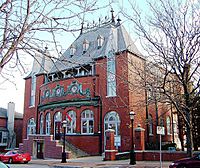
One person who had a big impact on Quality Hill was Tom Pendergast. He was a powerful political leader in the city. In the early 1900s, his brother, Jim Pendergast, started a strong political group for the Democratic Party. This group soon gained almost complete control over politics in the area. Tom Pendergast took over from his brother as the leader of this group.
In 1941, Tom Pendergast helped arrange for President Franklin D. Roosevelt's program, the Works Progress Administration, to build a large park on Quality Hill. This park overlooked the Kansas City Downtown Airport. This airport was also built during Pendergast's time. Today, this park is called Case Park. It covers the entire edge of Quality Hill's bluffs. Tom Pendergast also had a statue of his brother Jim placed in the park, and it is still there. Until the Kansas City International Airport opened in 1972, Case Park was a popular place to watch planes take off from the Downtown Airport. Planes had to climb very steeply to avoid the 200-foot bluffs and Quality Hill's buildings. The Kansas City Riverfront Bicycle Trail, a 20-mile bike path, also runs through the park.
In 1953, the American Hereford Association put a fiberglass statue of a bull on a tall pole at their headquarters. President Dwight D. Eisenhower was there for the event. Locals called the bull "Bob." People either loved it as a city symbol or thought it looked out of place. The statue was made by Will Decker with Rochetti and Parzini.
Changes and New Life
Starting in the 1960s, the number of people living downtown in Kansas City began to drop. Many wealthy families moved to newer, fancy areas further south. Because of this, houses in Quality Hill were divided into smaller apartments. The neighborhood slowly became run down.
In the early 1970s, a real estate developer named Arnold Garfinkel started buying properties. By 1976, he owned many large areas. Garfinkel created a plan to encourage investment in Quality Hill. He imagined building new structures and fixing up old ones. Garfinkel didn't complete his plan, but it inspired other investors. They began to fix up several old loft buildings. These new projects encouraged the Kansas City LCRA to update its downtown plan in 1983. This new plan included bringing Quality Hill back to life.
That same year, a development company called McCormack Baron Salazar was chosen to lead the project. They had a lot of experience fixing up historic buildings. The City, along with groups like the Hall Family Foundation, DST Systems, and J.E. Dunn, bought almost all of Quality Hill. McCormack Baron Salazar then built many new homes and businesses. They also fixed up many old buildings.
In the 1990s, the architecture company HNTB bought the American Hereford building for its main office. They removed the bull statue from the building. In 2002, HNTB and other companies arranged for the bull to be moved across I-35 to Mulkey Square.
In 2004, Kansas City Southern Industries finished building its new headquarters. It was designed to match Quality Hill's unique style. Around that time, State Street bought property from DST Systems and opened a big office there. The Heart of America United Way also has its main office in Quality Hill. It is in the old Virginia Hotel and a 19th-century house. In 2016, another old house was turned into Quality Hill Academy, a local charter school for young students.
Quality Hill Today
Since the late 1900s, Quality Hill has become a very popular and fancy urban neighborhood again. Many people see it as a great example of how old city areas can be successfully renewed. People want to live in Quality Hill because of its historic beauty. They also like being close to the cultural and business life of downtown Kansas City. The buildings, both old and new, show Kansas City's early style. It often looks like 19th-century French and Federal architecture. This is similar to the historic Soulard neighborhood in St. Louis.
In February 2008, McCormack Baron Salazar sold many of its buildings in Quality Hill. These buildings had 382 homes. They were sold to C.R.E.S. Management LLC, a company from Kansas City. This company planned to fix up all the buildings and the area around them. Many other properties in Quality Hill are owned by private people or businesses. Quality Hill also has some empty land. Most of this land belongs to DST Systems and the Kauffman Foundation. This includes some large parking lots and empty house lots.
The Kauffman Foundation has continued to fix up its remaining historic buildings to rent them out. Some residents have worried that parts of the neighborhood might be declining. McCormack Baron Salazar initially said they would help, but then decided to sell most of their property in Quality Hill.
Downtown Kansas City is growing fast. The number of people living downtown went from 3,000 in 2002 to over 16,000 in 2006. Quality Hill's population continues to grow quickly, and the cost of living there is going up.
The Quality Hill Playhouse puts on many Broadway and off-Broadway shows.
The River Club is one of two private clubs in Kansas City. It is located on Quality Hill, on 8th Street. It is near the Lewis and Clark historic site.
|


